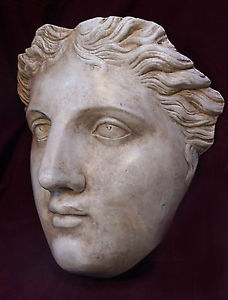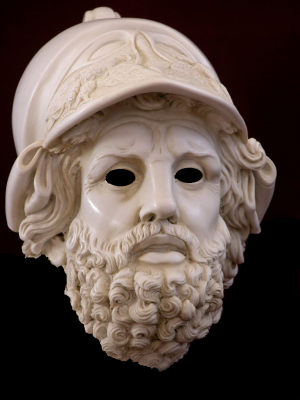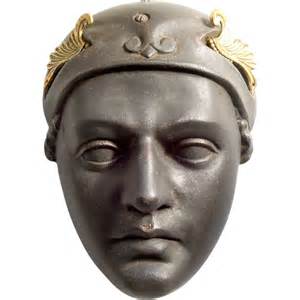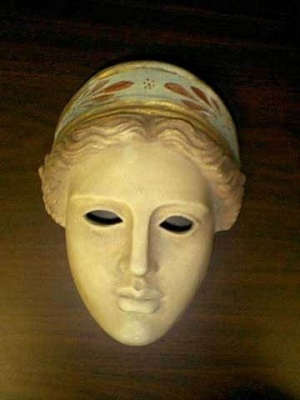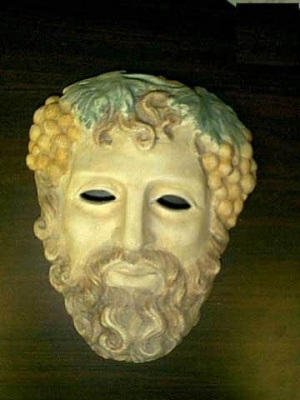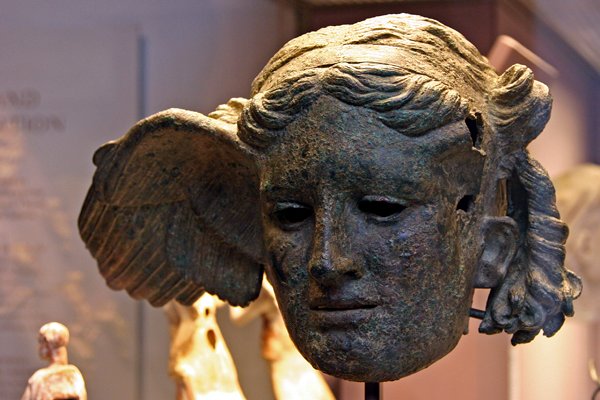Masks of Dii Consentes: Difference between revisions
No edit summary |
|||
| (17 intermediate revisions by 2 users not shown) | |||
| Line 90: | Line 90: | ||
---------------- | ---------------- | ||
== The Mask of Jupiter == | == The [[Mask of Jupiter]] == | ||
[[File:Mask of Jupiter.jpg|300px]] | [[File:Mask of Jupiter.jpg|300px]] | ||
<br> | |||
<br> | <br> | ||
'''This mask is made of a marble plaster, ivory, gold, silver, and copper melded and smoothed together in a beautiful mask. When put to the face is molds to the wearer, giving him or her slightly dusky skin, with pale brows. The mask gives the wearer abilities approximated so: [[Attributes| Charisma]] 5, [[Leadership]] 5, [[Presence]] 5, [[Thaumaturgy]] ([[Levinbolt]]) 5. Wearing the mask renders the wearers male.''' | '''This mask is made of a marble plaster, ivory, gold, silver, and copper melded and smoothed together in a beautiful mask. When put to the face is molds to the wearer, giving him or her slightly dusky skin, with pale brows. The mask gives the wearer abilities approximated so: [[Attributes| Charisma]] 5, [[Leadership]] 5, [[Presence]] 5, [[Thaumaturgy]] ([[Levinbolt]]) 5. Wearing the mask renders the wearers male.''' | ||
| Line 100: | Line 100: | ||
<br> | <br> | ||
== The Mask of Ceres == | == The [[Mask of Ceres]] == | ||
[[File:Masks of Dii Consentes Ceres.jpg|300px]] | [[File:Masks of Dii Consentes Ceres.jpg|300px]] | ||
<br> | <br> | ||
| Line 109: | Line 109: | ||
<br> | <br> | ||
== The Mask of Neptune == | == The [[Mask of Neptune]] == | ||
[[File:Mask of Olympus Poseidon.jpg|300px]] | [[File:Mask of Olympus Poseidon.jpg|300px]] | ||
<br> | <br> | ||
| Line 121: | Line 121: | ||
<br> | <br> | ||
== The Mask of Minerva == | == The [[Mask of Minerva]] == | ||
[[File:Masks of Dii Consentes Athena.jpg|300px]] | [[File:Masks of Dii Consentes Athena.jpg|300px]] | ||
<br> | <br> | ||
| Line 130: | Line 130: | ||
<br> | <br> | ||
== The [[Mask of Apollo | == The [[Mask of Apollo]] == | ||
[[File:Mask of Apollo.png|300px]] | [[File:Mask of Apollo.png|300px]] | ||
<br> | <br> | ||
| Line 142: | Line 142: | ||
<br> | <br> | ||
== The Mask of Juno == | == The [[Mask of Juno]] == | ||
[[File:Juno.JPG|300px]] | [[File:Juno.JPG|300px]] | ||
<br> | <br> | ||
<br> | <br> | ||
== The Mask of Mars == | == The [[Mask of Mars]] == | ||
[[File:Mask of Mars.png|300px]] | [[File:Mask of Mars.png|300px]] | ||
<br> | <br> | ||
<br> | <br> | ||
== The Mask of Venus == | == The [[Mask of Venus]] == | ||
[[File:Mask of venus.jpg| 300 px]] | [[File:Mask of venus.jpg| 300 px]] | ||
<br> | <br> | ||
<br> | <br> | ||
== The Mask of Vulcan == | == The [[Mask of Vulcan]] == | ||
[[File:Mask of Vulcan.jpg|300px]] | [[File:Mask of Vulcan.jpg|300px]] | ||
| Line 164: | Line 164: | ||
<br> | <br> | ||
== The Mask of Mercury == | == The [[Mask of Mercury]] == | ||
[[File:Mask of Mercury.jpg|300px]] | [[File:Mask of Mercury.jpg|300px]] | ||
<br> | <br> | ||
<br> | <br> | ||
== The Mask of Vesta == | == The [[Mask of Vesta]] == | ||
[[File: | [[File:Hestia2.png| 300 px]] | ||
<br> | <br> | ||
<br> | <br> | ||
| Line 180: | Line 180: | ||
<br> | <br> | ||
== The Mask of Bacchus == | == The [[Mask of Bacchus]] == | ||
[[File:Masks of Dii Consentes Bacchus.jpg|300px]] | [[File:Masks of Dii Consentes Bacchus.jpg|300px]] | ||
<br> | <br> | ||
| Line 217: | Line 217: | ||
;''In a diary found in London by the Tremere John Dee of an Archeologist [[Ottavio Cassano]],there were unannotated scribbles on a copy of ''Magus Ars Lexus'' about masks made by a rebellious apprentice named [[Vebronus Alexus Torenus]] of Hades, Cronus, and Rhea. The reality of these masks is doubtful.'' | ;''In a diary found in London by the Tremere John Dee of an Archeologist [[Ottavio Cassano]],there were unannotated scribbles on a copy of ''Magus Ars Lexus'' about masks made by a rebellious apprentice named [[Vebronus Alexus Torenus]] of Hades, Cronus, and Rhea. The reality of these masks is doubtful.'' | ||
==== The Mask of Cronus / Saturn ==== | ==== The [[Mask of Cronus]] / Saturn ==== | ||
[[File:Cronusmask.jpg|600px]] | [[File:Cronusmask.jpg|600px]] | ||
<br> | <br> | ||
| Line 223: | Line 223: | ||
(Berlin - January of 2043) ~~ ''Czere Ubireg - [[Czere Notebook]] / Ostanes' Notes'' {"The Magister 22:49, 22 March 2020 (MDT)"} | (Berlin - January of 2043) ~~ ''Czere Ubireg - [[Czere Notebook]] / Ostanes' Notes'' {"The Magister 22:49, 22 March 2020 (MDT)"} | ||
==== The Mask of Magna Mater ==== | ==== The [[Mask of Magna Mater]] ==== | ||
[[File:Mask of Magna Mater.jpg]] | [[File:Mask of Magna Mater.jpg]] | ||
<br> | <br> | ||
| Line 263: | Line 263: | ||
------- | ------- | ||
;[[Siege of Eretria]] | ;[[Siege of Eretria]] | ||
;[[On the Nature of Bargains]] | |||
Latest revision as of 20:41, 19 November 2023
- Arcane Objects -x- London -X- Melbourne -X- Paris -X- Naples Italy -x- Lore: Masks of Dii Consentes -|- Masks of Dii Consentes 1900 -|- Octavio Cassano's Diary
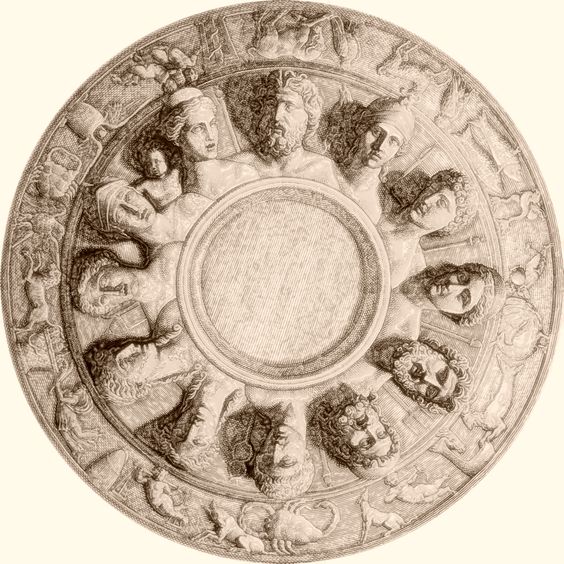
Introduction to the Gods: The Dii Consentes, also as Di or Dei Consentes (once Dii Complices), was a list of twelve major deities, six gods and six goddesses, in the pantheon of Ancient Rome. Their gilt statues stood in the Forum, later apparently in the Porticus Deorum Consentium.
The gods were listed by the poet Ennius in the late 3rd century BC in a paraphrase of an unknown Greek poet:
- Juno, Vesta, Minerva, Ceres, Diana, Venus,
- Mars, Mercury, Jupiter, Neptune, Vulcan, Apollo
Livy arranges them in six male-female pairs: Jupiter-Juno, Neptune-Minerva, Mars-Venus, Apollo-Diana, Vulcan-Vesta and Mercury-Ceres. Three of the Dii Consentes formed the Capitoline Triad: Jupiter, Juno, and Minerva.
Background
The grouping of twelve deities has origins older than the Greek or Roman sources. The Greek grouping may have Anatolian, more precisely Lycian origins. A group of twelve Hittite gods is known both from cuneiform texts and from artistic representation. The Hittite Twelve are all male, with no individualizing features. They have a possible reflex in a Lycian group of twelve gods in the Roman Empire period. By 400 BC, a precinct dedicated to twelve gods existed at the marketplace in Xanthos in Lycia.
Herodotus also refers to a group of twelve gods in Egypt, but this finds no confirmation in Egyptian sources. The Greek cult of the Twelve Olympians can be traced to 6th century BC Athens and probably has no precedent in the Mycenaean period. The altar to the Twelve Olympians at Athens is usually dated to the archonship of the younger Pesistratos, in 522/521 BC. By the 5th century BC there are well-attested cults of the Twelve Olympians in Olympia and at the Hieron on the Bosphoros.
The references to twelve Etruscan deities are due to later Roman authors, writing long after the influence of the Greek pantheon had become dominant, and must be regarded with skepticism. Arnobius states that the Etruscans had a set of six male and six female deities which they called consentes and complices because they rose and set together, implying an astronomical significance, and that these twelve acted as councillors of Jupiter. Scholarly evaluation of this account is dependent on the hypothesis that the Etruscans originally immigrated to Italy from Anatolia. In this case, the Etruscan Twelve might have been cognate to the Hittite Twelve. It is, however, just as possible that the Etruscan Twelve were simply an adaptation of the Greek Twelve just like the Roman Twelve.
Twelve Olympians: the equivalent grouping of the Greek pantheon
In the ancient Greek religion and Greek mythology, the Twelve Olympians are the major deities of the Greek pantheon, commonly considered to be Zeus, Hera, Poseidon, Demeter, Athena, Apollo, Artemis, Ares, Aphrodite, Hephaestus, Hermes and either Hestia, or Dionysus. Hades and Persephone were sometimes included as part of the twelve Olympians (primarily due to the influence of the Eleusinian Mysteries), although in general Hades was excluded, because he resided permanently in the underworld and never visited Olympus.
Concept
The Twelve Olympians, also known as the Dodekatheon (Greek: Δωδεκάθεον,δώδεκα, dōdeka, "twelve" and θεοί, theoi, "gods"), were the principal deities of the Greek pantheon, said to reside atop Mount Olympus. The Olympians gained their supremacy in a war of gods in which Zeus led his siblings to victory over the Titans.
The concept of the "Twelve Gods" is older than any extant Greek or Roman sources. The gods meet in council in the Homeric epics, but the first ancient reference to religious ceremonies for the Olympians collectively is found in the Homeric Hymn to Hermes. The Greek cult of the Twelve Olympians can be traced to 6th-century BC Athens and probably has no precedent in the Mycenaean period. The Altar of the Twelve Gods at Athens is usually dated to the archonship of the younger Pesistratos, in 522/521 BC.
In ancient Greek religion, the "Olympian Gods" and the "Cults of Twelve Gods" were often relatively distinct concepts.
Membership
While the number was fixed at twelve, there was considerable variation as to which deities were included. However, the twelve as most commonly portrayed in art and poetry were Zeus, Hera, Poseidon, Demeter, Athena, Apollo, Artemis, Ares, Aphrodite, Hephaestus, Hermes and either Hestia, or Dionysus.
Hades, known in the Eleusinian tradition as Pluto, was not usually included among the Olympians because his realm was the underworld. Plato connected the Twelve Olympians with the twelve months, and implies that he considered Pluto one of the twelve in proposing that the final month be devoted to him and the spirits of the dead. In Phaedrus, Plato seems to exclude Hestia from the rank of "the twelve great gods".
At Olympia there were six altars dedicated to six pairs of gods: Zeus and Poseidon, Hera and Athena, Hermes and Apollo, the Charites and Dionysus, Artemis and Alpheus, and Cronus and Rhea. The historian Herodotus states that Heracles was included as one of the Twelve by some. At Kos, Heracles and Dionysus are added to the Twelve, and Ares and Hephaestus are not. For Pindar, the Bibliotheca, and Herodorus, Heracles is not one of the Twelve Gods, but the one who established their cult. Lucian (2nd century AD) includes Heracles and Asclepius as members of the Twelve, without explaining which two had to give way for them.
Hebe, Helios, Selene, Eos, Eros and Persephone are other important gods and goddesses who are sometimes included in a group of twelve.[citation needed] Eros is often depicted alongside the other twelve, especially his mother Aphrodite, but not usually counted in their number.
The Roman poet Ennius gives the Roman equivalents (the Dii Consentes) as six male-female complements, preserving the place of Vesta (Greek Hestia), who played a crucial role in Roman religion as a state goddess maintained by the Vestals.
The major Olympians (the Dii Consentes)
- Zeus / Jupiter -- King of the gods and ruler of Mount Olympus; god of the sky, lightning, thunder, law, order, justice. Youngest child of the Titans Cronus and Rhea. Symbols include the thunderbolt, eagle, oak tree, scepter, and scales. Brother and husband of Hera, although he had many lovers, also brother of Poseidon, Hades, Demeter, and Hestia.
- Hera / Juno -- Queen of the gods and the goddess of marriage and family. Symbols include the peacock, cuckoo, and cow. Youngest daughter of Cronus and Rhea. Wife and sister of Zeus. Being the goddess of marriage, she frequently tried to get revenge on Zeus' lovers and their children.
- Poseidon / Neptune -- God of the seas, earthquakes, and tidal wave. Symbols include the horse, bull, dolphin, and trident. Middle son of Cronus and Rhea. Brother of Zeus and Hades. Married to the Nereid Amphitrite, although, like most male Greek Gods, he had many lovers.
- Demeter / Ceres -- Goddess of fertility, agriculture, nature, and the seasons. Symbols include the poppy, wheat, torch, cornucopia, and pig. Middle daughter of Cronus and Rhea.
- Athena / Minerva -- Goddess of wisdom, reason, intelligent activity, literature, handicrafts and science, defense and strategic warfare. Symbols include the owl and the olive tree. Daughter of Zeus and the Oceanid Metis, she rose from her father's head fully grown and in full battle armor.
- Apollo / Apollo -- God of light, prophecy, inspiration, poetry, music and arts, medicine and healing. Son of Zeus and Leto. Symbols include the sun, lyre, swan, and mouse. Twin brother of Artemis.
- Artemis / Diana -- Goddess of the hunt, virginity, archery, the moon, and all animals. Symbols include the moon, deer, hound, she-bear, snake, cypress tree, and bow and arrow. Daughter of Zeus and Leto and twin sister of Apollo.
- Ares / Mars -- God of war, violence, and bloodshed. Symbols include the boar, serpent, dog, vulture, spear, and shield. Son of Zeus and Hera, all the other gods (except Aphrodite) despised him. His Latin name, Mars, gave us the word "martial."
- Aphrodite / Venus -- Goddess of love, beauty, and desire. Symbols include the dove, bird, apple, bee, swan, myrtle, and rose. Daughter of Zeus and the Oceanid Dione, or perhaps born from the sea foam after Uranus' semen dripped into the sea after being castrated by his youngest son, Cronus, who then threw his father's genitals into the sea. Married to Hephaestus, although she had many adulterous affairs, most notably with Ares. Her name gave us the word "aphrodisiac", while her Latin name, Venus, gave us the word "venereal".
- Hephaestus / Vulcan -- Master blacksmith and craftsman of the gods; god of fire and the forge. Symbols include fire, anvil, axe, donkey, hammer, tongs, and quail. Son of Hera, either by Zeus or alone. Married to Aphrodite, though unlike most divine husbands, he was rarely ever licentious. His Latin name, Vulcan, gave us the word "volcano."
- Hermes / Mercury -- Messenger of the gods; god of commerce, thieves, eloquence and streets. Symbols include the caduceus (staff entwined with two snakes), winged sandals and cap, stork, and tortoise (whose shell he used to invent the lyre). Son of Zeus and the nymph Maia. The second-youngest Olympian, just older than Dionysus.
- Hestia / Vesta -- Goddess of the hearth and of the right ordering of domesticity and the family; she was born into the first Olympian generation and was one of the original twelve Olympians. Some lists of the Twelve Olympians omit her in favor of Dionysus, but the speculation that she gave her throne to him in order to keep the peace seems to be modern invention. She is the first child of Cronus and Rhea, eldest sister of Hades, Demeter, Poseidon, Hera, and Zeus.
- Dionysus / Bacchus -- God of wine, celebrations, and ecstasy. Patron god of the art of theatre. Symbols include the grapevine, ivy, cup, tiger, panther, leopard, dolphin, goat, and pinecone. Son of Zeus and the mortal Theban princess Semele. Married to the Cretan princess Ariadne. The youngest Olympian god, as well as the only one to have a mortal mother.
Chthonian Gods & Titans
- Hades / Pluto - Orcus / Dis Pater -- God of the Underworld, dead and the riches under the Earth; he was born into the first Olympian generation, the elder brother of Zeus, Poseidon, Hera, and Demeter, and younger brother of Hestia, but as he lives in the Underworld rather than on Mount Olympus, he is typically not included amongst the twelve Olympians.
- Cybele / Rhea / Magna Mater -- is the Titaness daughter of the earth goddess Gaia and the sky god Uranus, in Greek mythology and sister and wife to Cronus. In early traditions, she is known as "the mother of gods" and therefore is strongly associated with Gaia and Cybele, who have similar functions. The classical Greeks saw her as the mother of the Olympian goddesses and gods, but not as an Olympian goddess in her own right. The Romans identified her with Magna Mater (their form of Cybele), and the Goddess Ops.
- Cronus / Saturn -- also known as Kronos, was the leader and youngest of the first generation of Titans, the divine descendants of Uranus, the sky, and Gaia, the earth. He overthrew his father and ruled during the mythological Golden Age, until he was overthrown by his own son Zeus and imprisoned in Tartarus.
Origins of the Masks Dii Consentes
- These masks are written about in highly rare versions of the Magus Ars Lexus. Up until 2035 they were buried in a tomb outside Pompeii. It is not known if all the Masks were present or if some are lost to the sands of time. These masks were constructed by the artist Phidias, around 420 BC at Olympia. Phidias was a Mage of some power, and historical documents held by the Order of Hermes tell how he worked his magic by math and various rites worked in the names and styles of Roman Gods. Phidias was known for having made several objects of power in his time, which had famous use.
- In a diary found in London by the Tremere John Dee of an Archeologist Ottavio Cassano,there were unannotated scribbles on a copy of Magus Ars Lexus about masks made by a rebellious apprentice named Vebronus Alexus Torenus of Hades, Cronus, and Rhea. The reality of these masks is doubtful.
The Altar of Di Consentes
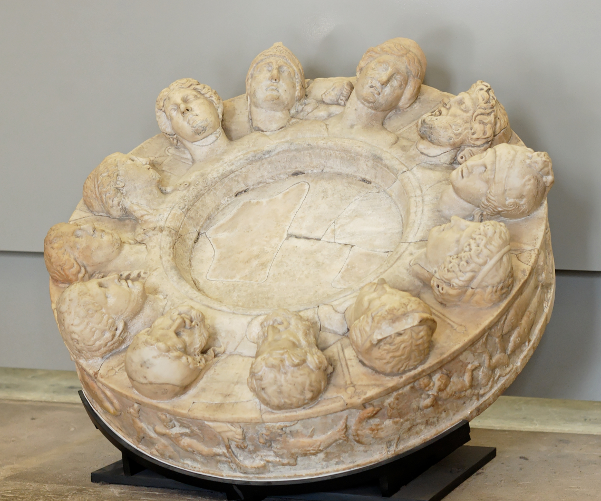
Although the ritual purpose of this 1st-century BC altar from Gabii is unclear, the twelve deities depicted correspond to the Dii Consentes.
The Altar of Dii Consentes is being kept in the Louvre of Paris in the Antiquities section of the museum. This one ton marble Altar rests on a raised platform. The Altar was built by Phidias concurrent with the crafting of the masks. Correct use of the Altar in conjunction with the satisfaction of the Masks is detailed by the Magus Ars Lexus.
The Mask of Jupiter

This mask is made of a marble plaster, ivory, gold, silver, and copper melded and smoothed together in a beautiful mask. When put to the face is molds to the wearer, giving him or her slightly dusky skin, with pale brows. The mask gives the wearer abilities approximated so: Charisma 5, Leadership 5, Presence 5, Thaumaturgy (Levinbolt) 5. Wearing the mask renders the wearers male.
(Melbourne 2042) ~~ Czere Ubireg - Czere Notebook / Ostanes' Notes {"The Magister 22:48, 22 March 2020 (MDT)"}
The Mask of Ceres
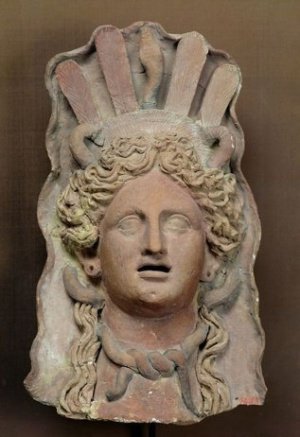
As the keeper of the laws of life and death this mask has the most interest to those of Necromantic leanings. Made of Ivory, gold, and amathyst the mask is surpisingly very light to hold. The mask when worn renders the wearer female, if they are not already. The mask gives the wearer abilities approximated so: Intelligence 5, Empathy 5, Healer Valeren 5, Necromancy 5 (Path of Ruin) 5
(Melbourne 2042) ~~ Czere Ubireg - Czere Notebook / Ostanes' Notes {"The Magister 22:48, 22 March 2020 (MDT)"}
The Mask of Neptune
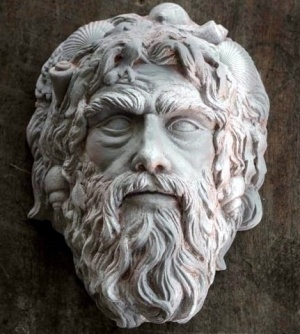
Neptune is the Lord of all water. The Mask of Neptune is constructed of Ivory, Jade, Gold, and Brass. Wearing the mask grants the following abilities approximated as: Perception 5, Intimidation 5, Celerity 5, Thaumaturgy 5,(Neptune's Might) 5
Neptunes mask is one of the Maggiore Machere.
Czere Ubireg dropped the mask out his plane, where it landed on the Isla di Ponza.
(Pompeii 2042) ~~ Czere Ubireg - Czere Notebook / Ostanes' Notes {"The Magister 22:47, 22 March 2020 (MDT)"}
The Mask of Minerva

Minerva is the Lady of Artisans. Her mask is made of Ivory, Copper, Silver, and Rubies. The abilities conferred by the mask are approximated here: Perception 5, Crafts 5, Auspex 5, Thaumaturgy (Ars Memorativa) 5
(Melbourne 2042) ~~ Czere Ubireg - Czere Notebook / Ostanes' Notes {"The Magister 22:48, 22 March 2020 (MDT)"}
The Mask of Apollo
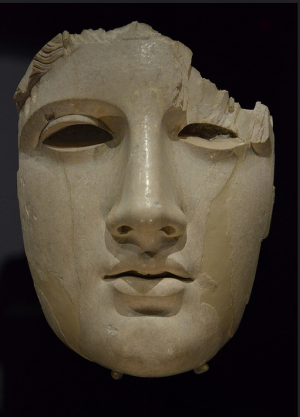
The mask is healing itself every time it is fed blood. The mask is now 90% complete and beginning to look like new. When attempts to communicate with the Mask are made, it takes on a warm, fleshy tone. Liked being called Pythios.
The Mask is now complete following the ritual performed by Czere Ubireg. While it's powers are at full strength now, the Avatar is unstable and inclined to all sorts of trickery. The end goal of all the Masks, but that of Apollo especially is bringing the light of change to the world. Some call that fire and anarchy, but it all depends on your point of view.
Apollo is one of the Maggior Machere.
(Paris 1900 Musée national du Moyen Âge) / (Melbourne 2042) ~~ Czere Ubireg - Czere Notebook / Ostanes' Notes {"The Magister 22:48, 22 March 2020 (MDT)"}
The Mask of Juno
The Mask of Mars
The Mask of Venus
The Mask of Vulcan
(Melbourne 2042) ~~ Czere Ubireg - Czere Notebook / Ostanes' Notes {"The Magister 22:59, 22 March 2020 (MDT)"}
The Mask of Mercury
The Mask of Vesta
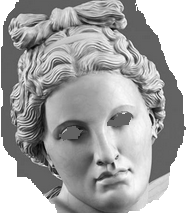
(Paris 1900 in the possession of the Mesdames de la Vigne Questing at the Parc des Buttes Chaumont) ~~ Czere Ubireg - Czere Notebook / Ostanes' Notes {"The Magister 23:03, 22 March 2020 (MDT)"}
The Mask of Diana
The Mask of Bacchus
Keepers of the Masks
Last known in the Ars Magus Lexus to be in the sepulchre of Theiea Ariadne.
Also entombed with her was Isa Mac Aba and Siors Aldegar.
The Sibylline Books
History
The books were also known to the Greeks. They were kept in the Temple of Apollo at Gergis on Mount Ida (near Troy in Asia Minor) in the 7th century BC, and said to be written by the Hellespontine Sibyl. From there, it passed to Erythrae (in eastern Asia Minor) and was called the work of the Erythraean Sibyl. It seems that this collection travelled from there to Cumae, Italy and from there to Rome. Tarquin buys the Sibylline Books, in Comic History of Rome (1850s book)
According to Virgil in the Aeneid, Aeneas had consulted the Cumaean Sibyl before he travelled to the lower world. The story of how king Tarquinius bought them from the Cumaean Sibyl was a famous legend. She offered to sell Tarquin a collection of nine books of prophecy, but he refused the price, so she burnt three. After that she offered to sell the six remaining books for the same price. He refused again and she burnt another three. Finally he bought these three remaining books for this price so they would not be destroyed, and put them in the temple of Jupiter in Rome.
The books were given to the trust of two Roman patricians (nobles). Beginning in 367 BC, ten keepers - five from the patricians and five from the common citizens - were appointed for them. After this (possibly the time of Sulla, 88-78 BC), the number of keepers was increased to fifteen. The job of these keepers was to consult the books on what was the right action or ceremony to escape from threats. Even so, they would not reveal the prophecies themselves, but only tell the action or ceremony needed.
The influence of the books brought eastern gods such as Apollo, the "Great Mother" Cybele, and Ceres, as well as Greek pagan beliefs, into the Roman pagan religion.
Because the verses were written in Greek, the keepers would always be helped by two Greek translators. The books were destroyed when the Temple of Jupiter burned down in 83 BC. Because of this, the Roman Senate sent messengers in 76 BC to find similar prophecies and replace them. The prophecies were gathered especially from Troy, Erythrae, Samos island, 'Africa' (that is, modern Tunisia), and from Sicily and Tibur in Italy. After they brought the new collection to Rome, Roman priests separated what they thought was true, but threw others out of the collection.
The Roman Emperor Augustus in 12 BC moved them to the Temple of Apollo, when they were studied and a new copy was made. They stayed there until 405 AD. It is said that at that time, Stilicho, who fought for the teachings of Arianism, burnt them.
Modern scholars believe these books are not the same as the Sibylline Oracles that were often quoted by early Christian writers from the 2nd century through the 5th century AD. It is certain that when one Christian writer, Athenagoras of Athens, wrote A Plea for the Christians to Emperor Marcus Aurelius in around 176 AD, at a time when Christians were being punished by the pagan Roman Empire, he quoted word-for-word from these Oracles that are known today. Quoting them along with writings by Homer and Hesiod, he wrote many times that "these books are all known to Caesar" (the Emperor). The Sibylline Books were still to be found in the Temple of Apollo at Rome at this time, so it is thought possible that at least some of these Sibylline Oracles were partly the same.
70 lines agreed to be from the real Sibylline Books were quoted in the 2nd century Book of Marvels by Phlegon of Trales. This quote speaks about the birth of a hermaphrodite, and ceremonies for sacrificing to idols.
Torenus' Masks: Masks of the Di Inferi
- In a diary found in London by the Tremere John Dee of an Archeologist Ottavio Cassano,there were unannotated scribbles on a copy of Magus Ars Lexus about masks made by a rebellious apprentice named Vebronus Alexus Torenus of Hades, Cronus, and Rhea. The reality of these masks is doubtful.
The Mask of Cronus / Saturn
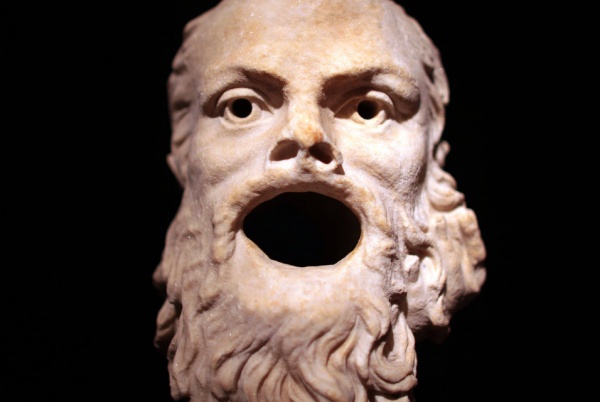
(Berlin - January of 2043) ~~ Czere Ubireg - Czere Notebook / Ostanes' Notes {"The Magister 22:49, 22 March 2020 (MDT)"}
The Mask of Magna Mater
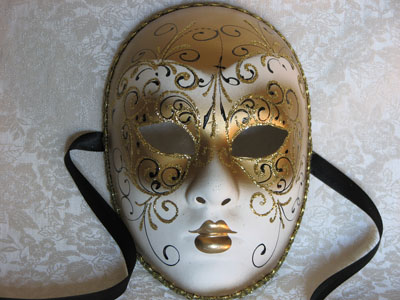
The Mask of Rhea, or Magna Mater as she was known, was found by Bernard Mooreau. The Tremere found himself unable to resist the call of the Mask, and eventually put it on. Since then the Avatar has worked it's way through his psyche, and the vampire is no longer in control of himself. The powerful id of the Mask has pushed his personality mostly to the side, making him it's tool. When Mooreau lived out a mortal lifespan, the Avatar chose to change vessels, and took that of Hedrina Sommer. Hedrina took up the mask lusting for the power it would bring her. Over time by following the dictates of the mask, it gradually took over her personality.
The Masks greatest desire comes in it's desire to bring fertility and change to the world around it. It has no love for vampires, as they are dead and can not reproduce and spread it's glory. Only those who cannot have children are immune to it's pull. If someone can get the mask off of the face of Sommer, it will become inert once more. But the Mask will be working to make sure that never happens...unless it is to change to a new vessel.
Anyone wearing the Mask of Magna Mater will take on the form of her Avatar. The Magna Mater can take on any female form it wishes, though it will never take on a form that would not allow it to procreate, so no pre-pubescent children, no elderly women.

(Pompeii 2042) ~~ Czere Ubireg - Czere Notebook / Ostanes' Notes {"The Magister 22:51, 22 March 2020 (MDT)"}
The Mask of Hades
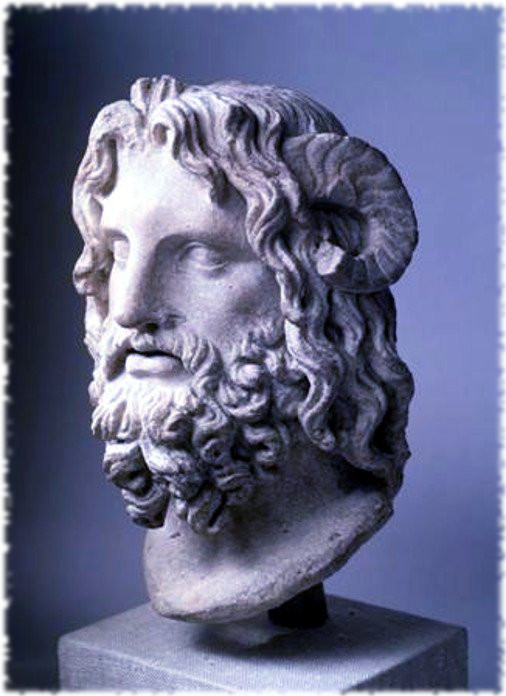
(Melbourne 2042) ~~ Czere Ubireg - Czere Notebook / Ostanes' Notes {"The Magister 22:51, 22 March 2020 (MDT)"}
Mask of Hypnos
- -- Hypnos -- Greek God of Sleep
https://en.wikipedia.org/wiki/Hypnos
https://en.wikipedia.org/wiki/Dii_Consentes
